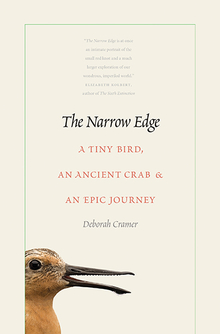Deborah Cramer - The Narrow Edge
Deborah Cramer 2015. The Narrow Edge. A tiny bird, an ancient crab & an epic journey. Yale University Press: New Haven, 293 pp.

I can’t remember why I put off reading this when it was first published, but that was a mistake. A great read, thoroughly researched and referenced but most importantly thoughtful, measured but still a passionate exploration of the world of the Red Knot. Got a bit of the Silent Spring about it (as others have noted). Every bit as informative and evocative and enjoyable as Adam Nicolson’s The Seabird’s Cry, and similar in many ways.
Made the more memorable by seeing my first Red Knot, almost ready to migrate, in spectacular breeding plumage near Toora on Corner Inlet - before I had finished reading the book.
Among the things Deborah Cramer does especially well is evoke the environment and the researchers along the flyway of the Red Knot, from Tierra del Fuego to the Arctic and many places between; and to set out the rich network of connections between Red Knot and local weather and environmental change, climate change, crashes of dependent species (bivalves, Limulus, … ). Of course human impacts on local, continental and global scales usually cause even greater disturbances but it seems clear that there never has been a “balance”. Yet they hang on, so far. Rich pickings on shorebird phylogeny and on Red Knot phylogeography and palaeo-flyway speculation to follow up from the extensive bibliography:


